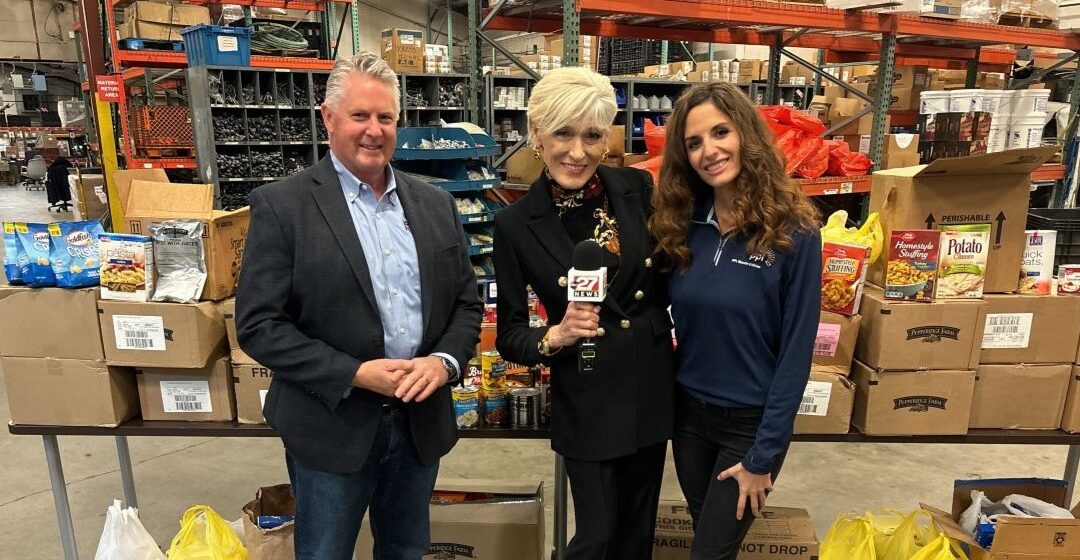
Nov 26, 2024 | Community Involvement
Central and eastern Pennsylvania are special places. We’ve felt that way for over 100 years because of our communities and the people who live here. And the holidays are an annual reminder of family and community, as we rally around each other with the hope of bringing warmth, joy – and food – to all.
But not everyone is able to fill their homes with the food they need. That’s why we and our employees are teaming up with local organizations to help make sure nobody goes hungry this holiday season.
We are joining abc27 News and the Central Pennsylvania Food Bank in Harrisburg for the annual Feed a Local Family campaign, which aims to increase charitable donations to the food bank. Joe Arthur, CEO of the food bank, says that it is currently in a “hunger crisis,” serving more families and individuals in need than at the height of the pandemic.
“We’re fighting hunger all year long,” Arthur said. “But during the holiday season, we also want to make sure families in need have the great holiday foods that we all enjoy.”
Arthur and Soni Dimond, a reporter from abc27, recently stopped by our West Shore Service Center in Mechanicsburg. We recorded a few TV segments and also gave a donation to the Central Pennsylvania Food Bank. Our employees all chipped in to donate a total of 544 pounds of food.
“It’s fantastic to partner with the Central Pennsylvania Food Bank,” said Kelly Palmer, regional affairs director at PPL Electric Utilities. “Our partnership dates back several decades. They’re going to be able to get food on families’ tables who really need it.”
Even if you aren’t able to donate right now, the food bank is always accepting donations to feed its more than 250,000 monthly visitors. These donations can be food, but money can also be donated to purchase food.
“The best advice I have for people this time of year really is to give back to the community,” Palmer said. “This time of year tends to bring out the best in people. That’s what community is really about at the end of the day – doing the right thing and coming together to give back.
Click the link here to donate to the Central Pennsylvania Food Bank.
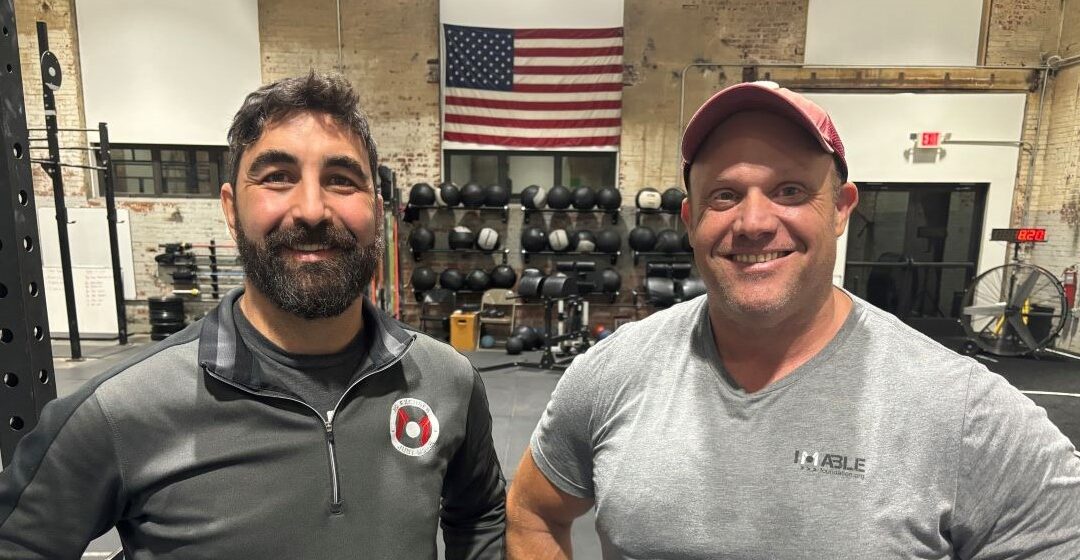
Nov 11, 2024 | Community Involvement, Diversity/Equity/Inclusion
Every Veterans Day, we honor all who have served in the military. Veterans at PPL Electric Utilities can join our PPLVets business resource group, which holds veteran-led meetings and events throughout the year. Through the PPL Foundation, we’re also proud to support organizations throughout our 29-county service territory that assist veterans.
The I’M ABLE Foundation is one of these organizations. The foundation is based in Wyomissing and is a recent recipient of a Powering Equity grant. I’M ABLE builds on its mission to remove obstacles for people with challenges, providing them with access to programs and equipment tailored to their needs.
In addition to providing free adaptive and inclusive group fitness programs for children, I’M ABLE also provides free fitness and mentorship opportunities for veterans though its Operation Lead from the Front program.
“The I’M ABLE Foundation is a place where people can come and get active – people of all abilities,” said Brian Sutherland, director of development for the I’M ABLE Foundation.
The foundation hosts classes at its gym twice a week and also takes part in events on select weekends. While the childrens’ and veterans’ fitness classes bring in different audiences, veterans have the opportunity to take part in mentoring and helping children in the foundation’s I’M FIT classes.
Jason Kish is a military veteran who has become a mentor for two children in the I’M FIT class.
“It just makes my life more enriched, just to get away from my normal day-to-day routine,” Kish said. “This is something that’s just hard to describe – how rewarding it is.”

A photo of Kish (left) and Josh (right) during one of the program’s I’M FIT classes.
Since I’M ABLE began hosting classes, attendance has jumped from an average of five participants to 40 per class. Sutherland says that this jump is thanks to donors like the PPL Foundation that make this programming free.
“You guys giving back to the community and making this possible for people of all abilities – it makes a difference,” he said. “All these kids can come together and just be celebrated for who they are and what they can do.”
“The work that they are doing to advance inclusivity in our community is so important,” said Kelly Palmer, PPL Electric Utilities regional affairs director. “It’s really meeting a community need, and it’s exactly the type of program we would want to fund through the Powering Equity grant. We are proud to support the I’M ABLE Foundation, and we are proud to support our veterans.”

Nov 7, 2024 | Community Involvement
As a staple of central and eastern Pennsylvania for over 100 years, we understand the critical importance of economic development. Through our growth as a company, we have powered businesses and empowered growth within communities throughout our 29-county service area.
We are committed to doing what we can to not only attract new businesses to our region, but also supporting the existing businesses and communities that have helped make Pennsylvania what it is today.
One of the ways we support our communities is through the Pennsylvania Department of Economic Development’s (DCED) Neighborhood Partnership Program (NPP). Whether it’s affordable housing, community services, crime prevention, job training or neighborhood assistance, we’re helping support nonprofit agencies working to better their neighborhoods through community development projects. We have been a long-time participant in the NPP program, and we value the positive impact this approach makes in each community.
We are currently assisting six nonprofits across Lancaster, Wilkes-Barre and the Greater Lehigh Valley.
“We could not have the level of beautification that we’ve had in downtown Wilkes-Barre without the assistance of PPL’s NPP contributions,” said Larry Newman, executive director of Wilkes-Barre’s Diamond City Partnership. “Having the partnership with PPL and other contributors allows us to leverage resources and punch far above our weight.”
Here are the six organizations we’re currently partnered with:
Community Action Development of Allentown (CADA) – Upside Allentown
We are involved in a six-year partnership with Upside Allentown to provide support for several youth-serving organizations in distressed Allentown neighborhoods:
- Generation Next at William Allen High School
- AfterZone, Allentown’s after-school initiative
- Allentown Police Department’s Youth Police Academy
- James Lawson Freedom School
Support through our partnership also includes the acquisition and renovation of a community center.
Community Action Development of Bethlehem – Southside Tomorrow
Our six-year partnership with Southside tomorrow seeks to address a number of community-based needs:
- A lack of quality, affordable renter and owner-occupied housing in an area of Bethlehem with the highest percentage of cost-burdened homeowners and renters
- A lack of access to fresh food and grocery stores
- A lack of vegetation and green spaces, as well as quality parks and recreational outlets
- A need for improved lighting and walkability of south Bethlehem
- A need for more connection between the community and the community’s institutions
- Challenges with cleanliness
Diamond City Partnership – Wilkes-Barre
“We work to improve downtown Wilkes-Barre’s environment, image and economy,” Newman said. “We have goals to help improve these areas. The downtown is still feeling the impacts from COVID, and NPP funding is helping us achieve our goals more broadly and at a higher level.”
Our six-year partnership with the Diamond City Partnership supports the nonprofit’s efforts to revitalize and beautify downtown Wilkes-Barre.
“Our goal is to shape a downtown that is a point of pride for everyone in our region, not just the downtown,” Newman said. “You simply cannot have a healthy community or region without a healthy downtown at its core. That’s what drives us every day.”
The organization was highlighted in a recent announcement for the Neighborhood Assistance Program (NAP). The partnership program is a part of the NAP. In an event held at the Diamond City Partnership, Pennsylvania announced it would be doubling its funding for the NAP program from $36 million to $72 million.
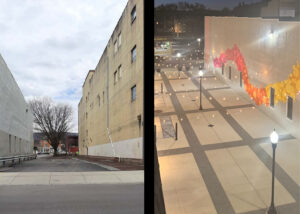
An alley in downtown Wilkes-Barre (left) was cleaned up and revitalized by the Diamond City Partnership. It has been repurposed into the SOMA Arts District (right), a new space for citygoers to visit and enjoy. This project was completed thanks in part to NPP funding.
“It was a chance to showcase to the Commonwealth and the media just what these partnerships can accomplish,” Newman said. “And we’re just very pleased and happy with the support that PPL has provided us because they understand how important this work is. They’ve been there for us.”
Hispanic Center Lehigh Valley
“At the base of our partnership is helping people meet their basic needs,” said Raymond Santiago, executive director of the Hispanic Center. “Meeting these needs allows people to flourish in their education, careers and family life, which in turn helps make a positive impact in the Lehigh Valley.”
Hispanic Center Lehigh Valley is supported on a year-to-year basis through the NAP program. We support economic recovery efforts serving vulnerable populations, with a focus on providing bilingual services to Hispanic/Latino residents. We are also supporting:
- A new bilingual Cultural and Linguistic Workforce Development Center
- The Social Service Program’s case management services
- Programming to support older adults’ health and wellness at the Hispanic Center’s senior center
- Meeting an increased demand for emergency food at the center’s food pantry
“We understand the importance of the work we do in making sure these groups are an active piece of the future of the Lehigh Valley,” Santiago said. “Right now, we’re able to meet the need of the community because of funding from PPL and our other partners.”
Spanish American Civic Association (SACA) – Tec Centro
Our six-year partnership with SACA’s Tec Centro program helps provide basic education and job training to low-income Latino individuals in Lancaster. The funding has helped SACA create two new occupational training areas for broadband training and renewable energy. Funding has also been used to invest in affordable housing, which is helping balance over-gentrification in the community. Furthermore, these contributions have been used to help leverage additional investments from Lancaster City and Lancaster County totaling $1 million. These investments will help develop a welding and metal fabrication occupational training area at Tec Centro.
Tenfold
We also have a six-year partnership with Lancaster’s Tenfold. Tenfold serves low-income residents of the City of Lancaster and Columbia Borough to help those experiencing housing and financial instability due to rising costs, stagnant wages and the aftermath of a global pandemic. The organization is using NPP funds to:
- Make critical home repairs to homeowners
- Support local affordable housing projects
- Provide eviction prevention assistance
The funds are also being used by Tenfold’s Financial Empowerment Center to provide one-on-one financial counseling, as well as workshops on budgeting, savings, improving credit scores and first-time homebuyer’s courses.
We take great pride in our NPP partnerships, and in the work that these organizations are doing to help build up their communities. We also know that these effects will be felt well beyond those directly impacted by these partnerships. A commitment to economic development is a commitment to community, and we look forward to continuing to support the places where we live and work.
“Even before I began working with the Hispanic Center, I worked closely with PPL on a number of campaigns,” Santiago said. “I know how much they care. It’s not only about the financial support, but also the time and talent that PPL employees donate.”
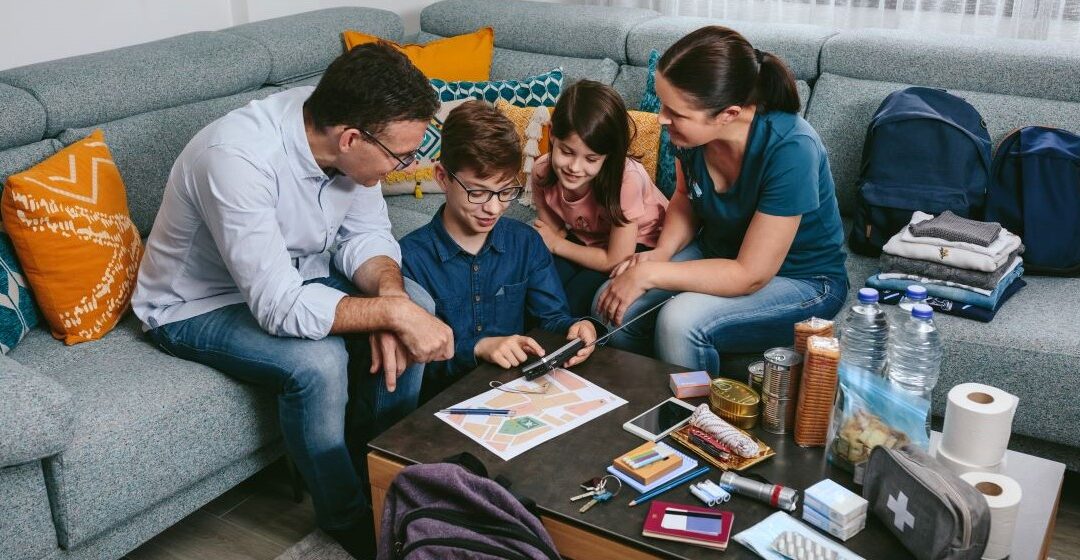
Nov 5, 2024 | Safety and Security
This Fall, persistent dry conditions and minimal rainfall have led to drought conditions throughout much of our 29-county service territory. When there are drought conditions, the risk of brush fires and wildfires increases. As first responders continue to battle a wildfire in Lehigh Township, it is an important reminder that having a plan for any emergency is the first step to ensuring you and your loved ones stay safe.
“The safety of our customers and the communities we serve is always our primary focus,” said Ed Harakel, vice president of Operations. “With dry conditions expected to continue, it’s important to be mindful of the heightened risk for fires and be prepared for any sudden changes.”
What can you do to prepare for wildfires?
- Prepare an emergency kit and be ready to put it in your vehicle.
- Follow wildfire prevention tips found at ready.gov/wildfires.
- Create an evacuation plan and make sure to practice that plan so that you can leave quickly if needed.
- Maintain your lawn and remove combustible debris from around your home.
- Download important mobile apps – FEMA and the National Weather Service – to receive timely updates and alerts.
- Sign up for PPL Electric alerts to receive important updates by visiting pplelectric.com/alerts.
What do we do to prepare?
We prepare year-round for emergencies, including wildfires, and are ready to respond at a moment’s notice around the clock to help protect our system and keep our customers safe. We do this by:
- Monitoring weather conditions and working with emergency management officials to guard against wildfire risks across our territory.
- Inspecting lines and other electric infrastructure.
- Making investments throughout the year to strengthen our electric delivery system against severe weather and natural disasters.
- Trimming trees and controlling brush along our right of ways to reduce the possibility of vegetation impacting power lines.
- Using innovation and automated tools to detect trouble and reroute power.
“Our team coordinates closely with local and state emergency management agencies, community liaisons and elected officials through regular communication all year,” said Harakel. “So, when a wildfire does occur, the PPL Electric team is boots on the ground with emergency responders continuously monitoring the situation.”
Should a fire become a larger threat to our system, know that we are prepared to take appropriate actions to lessen damage to the grid and minimize outages. If necessary, we will communicate important information and updates to you via phone, text or email. Now is a great time to sign up and customize your alert settings at pplelectric.com/alerts.
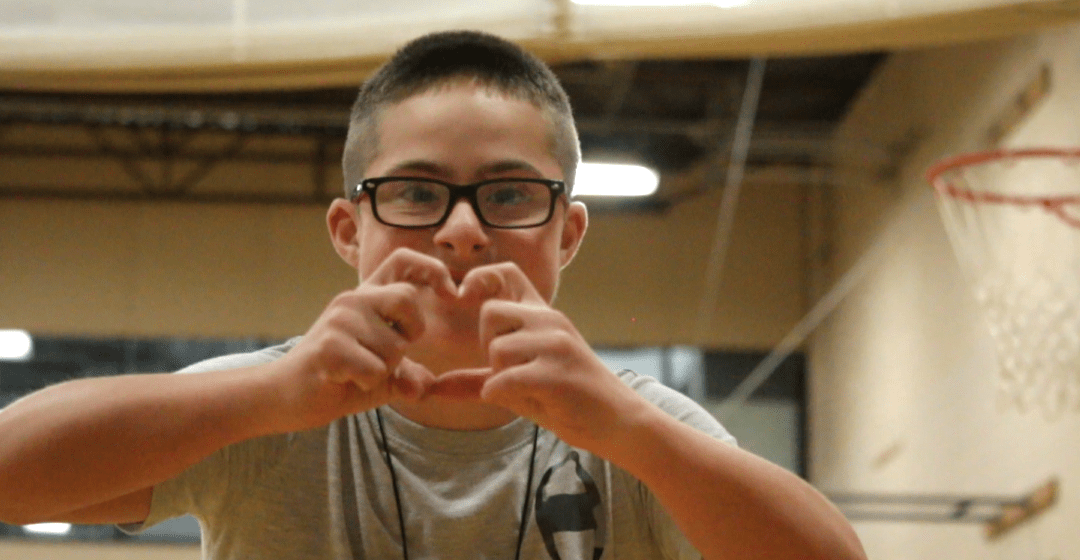
Oct 25, 2024 | Community Involvement
VIDEO: PPL making fitness accessible to all at the Bloomsburg Area YMCA
Through its grants, the PPL Foundation invests in building communities. There are a number of grant cycles year-round that support different initiatives. Every summer, the foundation awards Powering Equity grants to organizations that specifically work to promote greater equity and inclusion in the neighborhoods we serve.
The Bloomsburg Area YMCA is a recent recipient of a Powering Equity grant. It serves Columbia and Montour counties and is dedicated to youth development, healthy living and social responsibility. The YMCA is using the Powering Equity grant to support its growing Adaptive Health and Recreation Program for children with disabilities.
“This adaptive program is meant for kids ages three to 13,” said Collin Benfield, director of programs and membership development at the YMCA. “We try to offer a myriad of different sporting and recreational opportunities for kids that may not otherwise get them in a safe manner and in a manner that helps aid their physical therapy.”
The program kicked off in 2023, and it is currently offering its second cycle of classes. It’s quickly becoming popular in the area, growing from 10 children to 22 in the first year.
“The kids and the families love it,” said Wayne Stump, chief executive officer at the YMCA. “It’s evidenced by just how quickly this program has grown.”
There are two sessions during the year during the spring and fall. The current fall session is held on Wednesday nights, which is becoming the highlight of these kids’ weeks.
“Their feedback is that they want it more often – every day, if they could,” Benfield said. “It feels amazing knowing that we’re providing wellness for all…regardless of ability or disability.”
As the program expands and the numbers grow, the need for funding becomes more important.
“We wouldn’t be able to do it without the funding that we do get. We’re really appreciative of the PPL Foundation and others,” Stump said. “With the amount of costs that families have, this might be a burden if they had to pay for it.”
The YMCA says it looks forward to accepting more kids into the program and continuing to provide accessibility to all.
“To me and the rest of the grants committee, when programs benefit a wide range of diverse groups, that really makes them special,” said Jonah Howe, PPL Electric Utilities’ regional affairs director in the area. “We’re proud to support the Adaptive Health Program at the Bloomsburg YMCA.”







